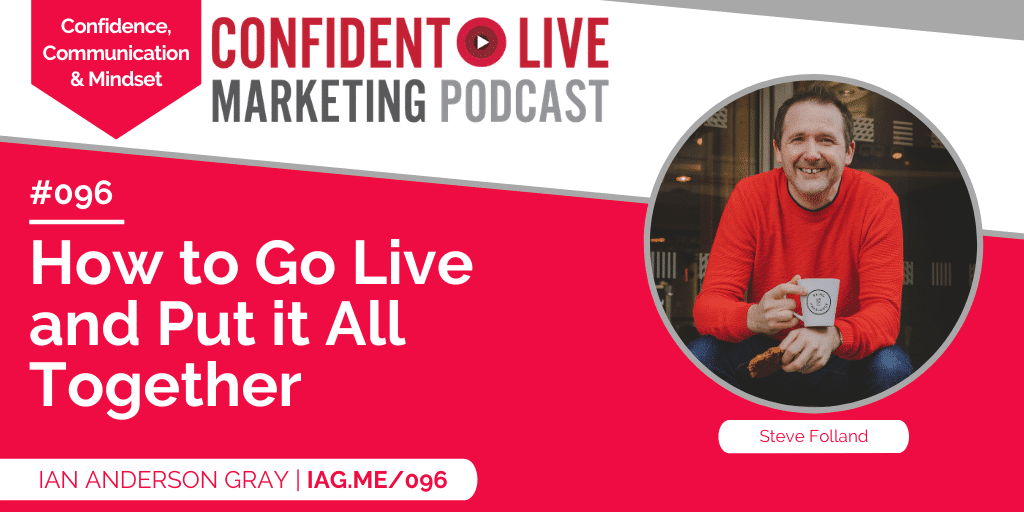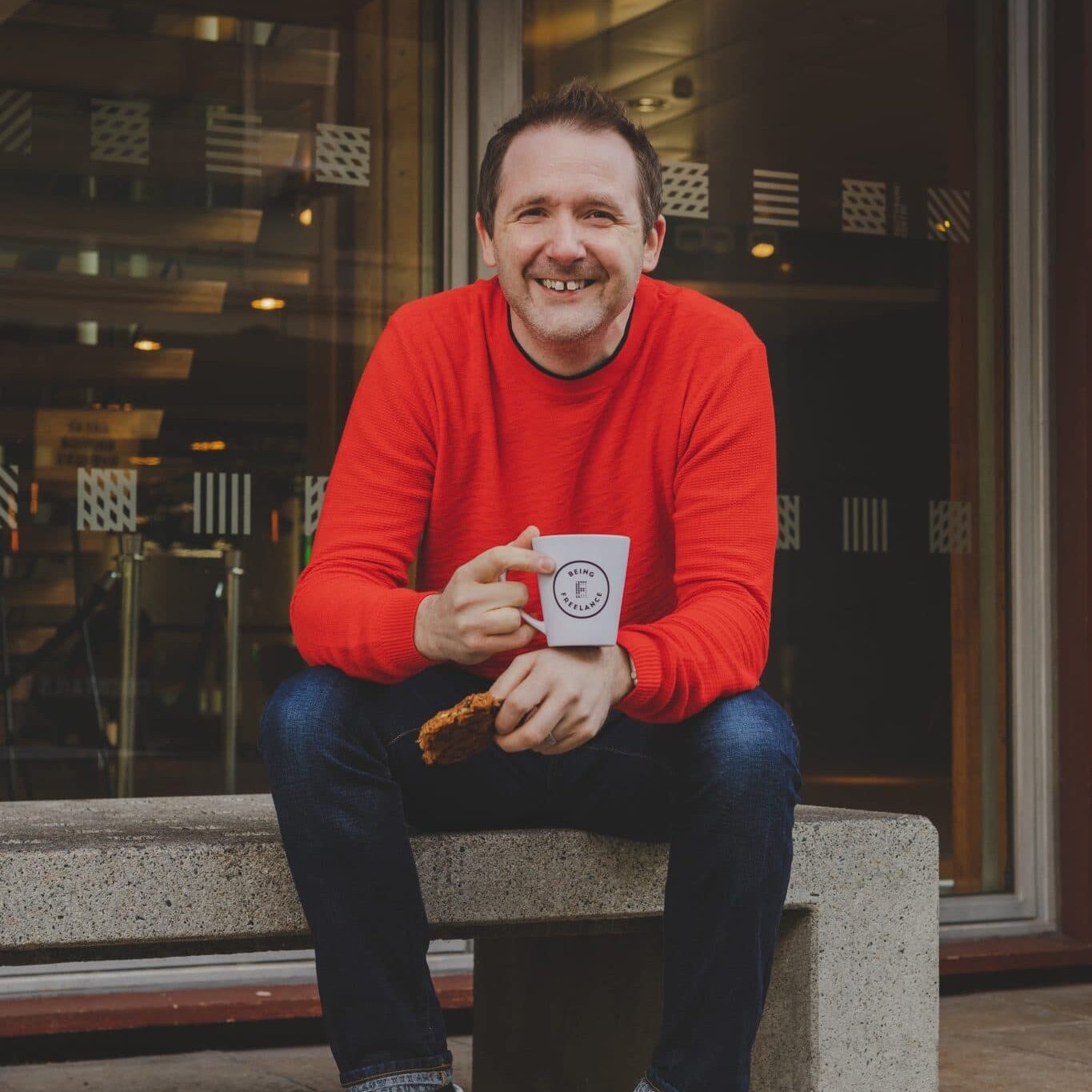How to Go Live and Put it All Together
Confident Live Marketing Podcast
Episode 96
Episode Theme: Confidence & Mindset
February 19, 2021

This week on the show I’m joined by the fabulous Steve Folland to talk about how to go live and pull it all together.
Steve Folland, is behind the long-running ‘Being Freelance’ podcast and co-hosts the award-winning ‘Doing it for the Kids’ podcast for self-employed parents. In his freelance community he hosts live Q and A's, award shows, a book club and a pop quiz.
What You’ll Learn…
[6:30] How did Steve get into this career?
[12:39] Does Steve still get nervous going live now?
[16:13] Why does Steve do live shows?
[19:59] How does Steve plan out his live shows?
[26:19] What’s your tips for interviewing live guests?
[30:01] What tech does Steve use to go live?
[35:04] How does Steve make a live show feel intimate?
[41:23] How does Steve promote his live shows?
How Did Steve Get Into This Career?
Listen at [06:30]
Steve studied media production at University and went on to fulfill his childhood dream of working in radio and creating documentaries. This set him up well for a life of live videos, it taught him how to think on his feet.
Seven years ago when his daughter was born, Steve decided to quit his full-time job and go fully freelance so that he could work from home and be there for his kids.
This ended up being the start of his podcast and community.
Does Steve Still Get Nervous Going Live Now?
Listen at [12:39]
Steve's experience stops him from feeling the nerves when he goes live.
"I tend to get nervous when I don't quite know what I'm doing. Once I've done something once I know how it's gonna work. Generally, if I don’t know what I’m doing, I will try and prepare in my head"
Preparation and practice are key to keeping the nerves at bay during live broadcasts or events. If you have that confidence in what you are presenting then that will settle you down. You’ll start to enjoy it rather than feel nervous.
When going live, nervousness can be positive, it can stop you from getting too complacent. Use nerves to your advantage. @sfollandClick To Tweet"When going live, nervousness can be positive, it can stop you from getting too complacent. Use nerves to your advantage."
Why Does Steve Do Live Shows?
Listen at [16:13]
Podcasts are a really polished way to communicate, but lives are much more casual and allow you to interact with your community in a much more intimate manner.
"When I go live, it's like me hanging out with the community of freelancers that are there with me. Plus you can interact with them, and see their comments"
Lives emulate an energy that is not able to be replicated via things such as pre-recorded podcasts.
Live shows emulate an energy that is not able to be replicated via things such as pre-recorded podcasts. @sfollandClick To TweetPlus, lives create a great community, especially for freelancers who often work alone and don’t get a lot of other interaction:
"Some people tune into my weekly show to see their fellow freelance friends. They're all part of it together and it really helps bring people together."
How Does Steve Plan Out His Live Shows?
Listen at [19:59]
There is a temptation to pursue perfectionism, which doesn’t exist and quite frankly is boring. It’s the quirkiness that makes lives fun and enjoyable.
But that doesn’t mean you can just go ahead and run the live show without a plan.
"Whilst it looks unprepared and shambolic, I do have a plan in my head. I’ll think about what I'm going to say. I don't have any notes, I'm just kind of riffing, but it's all in my head"
It’s key that you have a plan. But you also need to be flexible so that you can adapt if anything goes wrong. It needs to be professional and presented, but it doesn’t need to be polished.
"With a live Q&A I will always have some questions prepared in advance. That’s something that all radio shows do."
What’re Your Tips for Interviewing Live Guests?
Listen at [26:19]
It’s important to ask the right questions and give the interviewees space to answer in order to get the most from your interview.
"I really listen to what they say, and jot down notes and then I reflect their language back to them. So if they say a particular thing in a certain way, I might say that same phrase back even if it's much later on in the interview"
Listening and not talking over the guests is key, you really need to let them speak.
However, a Q&A is slightly different:
"You have to read the comments and think about the next questions, so it’s a skill that maybe you develop over time."
It’s okay to keep notes so that you can come back to something that has been said earlier in the interview.
What Tech Does Steve Use to Go Live?
Listen at [30:01]
While the interviewing techniques and planning is often the most important aspect of pulling together a show, our listeners are often interested in the tech side of how to record a live show.
"When I do it live outside, I simply use my iPhone and the Facebook app itself, or to go live on or whatever. The weekly updates can be frustrating, but If I accidentally click a filter then I mock the fact that it’s happened."
"Tech-wise when I podcast I use a Rode podcaster mic, I keep it as simple as possible"
It’s important to keep things simple, there is no need to overly complicate things. If you don’t have a lot going on then there is not a lot to go wrong.
How Does Steve Make a Live Show Feel Intimate?
Listen at [35:04]
Although you’re talking to loads of people, you want to make sure that it feels like you are only talking to one person.
"A lot of it is to do the language. So when I'm doing a podcast, I will say ‘you’. I will speak to whoever is watching the live video.And that’s how it feels more like a community."
Reading out the comments is also part of the strategy, this makes people feel involved in the conversation. It makes it feel like a community.
The most important thing is to keep encouraging people to get involved as this will help it feel more like an intimate conversation.
How Does Steve Promote His Live Shows?
Listen at [41:23]
After planning, pre-promoting and going live, it’s not time for a rest. There is more to do once the broadcast has gone live.
"I am very much aware that I can do more"
Steve goes over the comments from each live show to reply to each, this also gives him an idea of what people are talking about.
Live shows are great as they can be repurposed, and promoted via social media and emails.
"I always save my live videos and edit using VideoLeap, so I can share it via Twitter and Instagram. I can then re-purpose clips into highlight reels and add captions"
"I try to repurpose and promote as much as possible, to get the most out of each episode"
Keep it simple. There is no reason to overcomplicate things.
Watch Episode 96

Who is Steve Folland?
Steve is behind the long-running Being Freelance podcast and co-hosts the award-winning Doing It For The Kids podcast for self-employed parents.
In his freelance community he hosts live Q&As, awards shows, Book Club and pub quiz.
Full 'Steves' (marks) when it comes to being confident live.



Comments